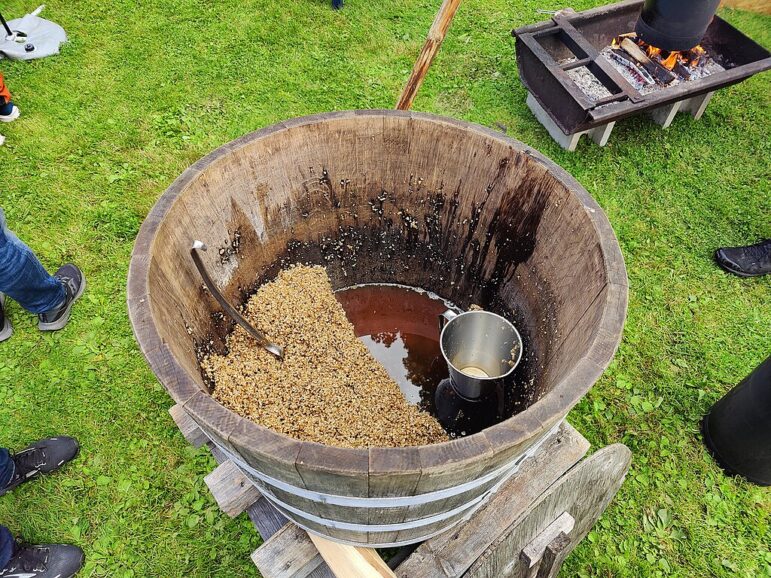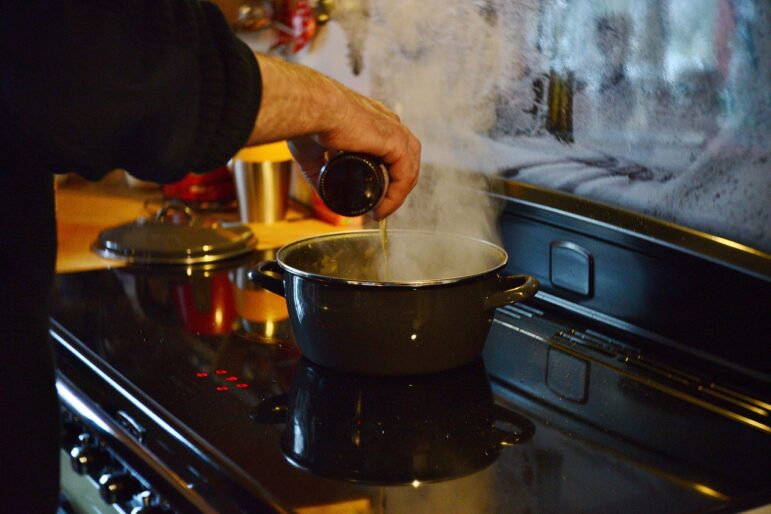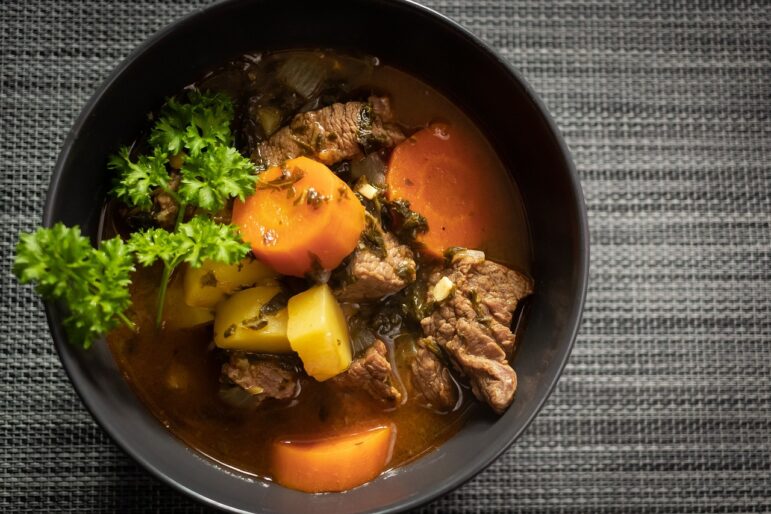
In the wake of Imbolc, Brigid is still on my mind, and I find myself thinking about beer.
Not just the nature of her relationship with it, or rather exactly which her that relationship properly belongs to, but why beer was important enough to merit divine notice in the first place – a question which will take us far beyond Ireland and Indo-European peoples, as beer’s importance to humanity is significantly broader, and older, than that.

Malt in a traditional malt tun after lautering, part of a brewing beer with a historical set of equipment. [Adjoka, public domain]
Strongly associated with Brigid in her Catholic form as the saintly nun of Kildare, we don’t know if this connection to beer was something she inherited from the goddess or if it’s unique to the saint, developing out of monastic orders’ role as breweries in the middle ages. While the scant sources we have on the goddess make no mention of beer, this absence doesn’t rule it out, and not just because there are so many gaps in our knowledge that a connection to beer could be hiding in. Brigid is, among many other things, both a divine provisioner and a civilisation bringer, introducing metalwork, poetry, medicine, and animal agriculture to the people of Ireland. Beer and the art of brewing would fit very well in this portfolio, because for many ancient peoples the discovery of beer was a divinely aided process, one that enabled humanity to cross the threshold between wild and civilised life.
It may seem strange to think of beer as a civilising influence, but that’s because our entire view of beer, and alcohol in general, has changed radically in the past 150 years. For most of human history, beer has been a staple part of the average person’s diet. Not because our ancestors were hopeless drunks, or even just because in many places plain water was unsafe to drink, but because beer was an essential source of calories and nutrients not otherwise available. Fermentation took a staple crop and raised its nutritional profile, the chemical processes introducing additional nutrients and increasing the bioavailability of others. For people constantly battling the threat of starvation, whose access to diverse foods was limited by season and climate, this was invaluable. More than that, if certain archaeologists are correct, it was revolutionary.
The Neolithic Revolution occurred around 10,000 BCE, when humans began to transition from nomadic to sedentary life in small settlements and villages. This transition saw the beginning of agriculture, where humans began purposely cultivating a small selection of the wild plants they’d relied on as foragers. A significantly more efficient system of food production, this allowed communities to dedicate more time to other forms of labour and develop specialised roles, while also drastically reducing the quality of their diet.
Though humans were now spending fewer hours a day dedicated to food production, and were significantly closer to achieving food security than ever before, they were also consuming a much narrower range of things. Malnutrition, tooth decay, and other health issues proliferated. Fermentation, specifically of staple cereal crops, helped to mitigate that, giving communities that included beer as a staple part of their diet an advantage over those that didn’t.
Neolithic peoples also valued beer for its psychoactive properties, so much so that some historians believe that the desire for beer may have served as the catalyst for the Neolithic Revolution. The discovery of beer predates the birth of agriculture by at least 1,000 years, in the area known as the Fertile Crescent. Wild grasses, the plants that would later become cereal crops, grew abundantly there, so much so that the bands of early humans in the region were able to harvest more than they needed. Though it’s unclear how exactly the method of fermentation was discovered, archaeological evidence tells us beer was an integral part of funerary and religious rites for these people very early on.

Pouring beer into a pot for cooking [Pixabay]
The desire for more and easier access to beer may have been what inspired those early forays into agriculture and cereal cultivation, as well as the establishment of the first proto-cities like Gobekli Tepe, inhabited for only part of the year during beer-fueled religious rites. Whether or not it was desire for more and easier access to beer that drove people toward settlement living, beer played an undeniably important role in early human society, facilitating both in-group cohesion and peaceful contact with outsiders through shared, ritualised drinking. This importance survived long enough to make it into our written sources, from mythological texts dealing with beer’s role in society, to the more mundane administrative records of various kingdoms that paid out wages in portions of beer.
Beer itself has undergone significant evolution from that first draught brewed in a cave 13,000 years ago. The earliest beers were far more like sour bread soups or porridges, and contained a much wider range of ingredients in addition to cereals than anything we’d recognise today. They also varied significantly in potency, with different varieties brewed for different purposes; many of the everyday beers consumed for nourishment were no more alcoholic than sourdough bread or contemporary “alcohol free” beers.
Beer could be both intoxicant and health food, something you drank to commune with gods or fed to an invalid so they’d regain their strength. It could get you blackout drunk or serve as a hearty breakfast before a day spent working under the desert sun. Though beer has become a purely recreational drink over the last century and a half, as changes in food production, water management, and attitudes towards alcohol have phased it out of daily life, for many of our ancestors it was essential – as sacred as fire, bread, and the other building blocks of civilised life.
Beef and Beer Stew
I decided to return to the origins of beer, at least in spirit, and use it to create a nourishing yet delicious stew that will keep you warm through the last gasp of winter. This should serve three to four, more if you pair it with bread or other side dishes.

Beef stew [Pixabay]
Ingredients
- 600g stewing beef
- Two onions
- Two celery ribs
- Two carrots
- Two to four potatoes
- One head of garlic (or to taste)
- One pint of dark beer
- Two beef stock cubes or equivalent
- Four Juniper berries (Omit if serving to a pregnant person)
- One teaspoon thyme
- One large bay leaf
- Black pepper to taste
- Salt to taste
- Oil
Dice the vegetables and fry them in your oil of choice until the onions turn translucent and everything else is soft. Then add the rest of the ingredients, topping up with water to ensure everything is covered, and simmer until the beef is soft.
I don’t sear the meat before I add it, because while searing will add additional flavour via the maillard reaction, it also results in tougher meat, and the idea that searing seals in the juices is sadly just a myth. However, that’s a personal preference on my part – feel free to sear it first if you so wish.
The Wild Hunt is not responsible for links to external content.
To join a conversation on this post:
Visit our The Wild Hunt subreddit! Point your favorite browser to https://www.reddit.com/r/The_Wild_Hunt_News/, then click “JOIN”. Make sure to click the bell, too, to be notified of new articles posted to our subreddit.
